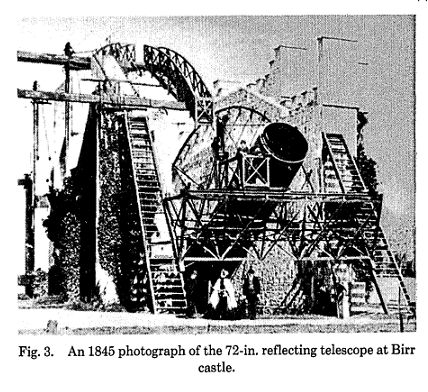…interesting if you believe the Jesuit-theorized cosmos’ moon…
PDF — Giant mirror of Birr Philip S Callahan Applied Optics 5 Optical Society America
CGPT —
The “Giant Mirror of Birr” refers to the Leviathan of Parsonstown, which was a groundbreaking astronomical telescope built in the mid-19th century at Birr Castle, in Birr, County Offaly, Ireland. It was not a mirror in the conventional sense, but rather the telescope’s primary component was a large speculum metal mirror, which made it the largest telescope in the world at the time of its completion. Here’s a closer look at this remarkable piece of scientific history:
### Background and Construction
– **Builder**: The telescope was designed and built by William Parsons, the 3rd Earl of Rosse, an accomplished astronomer and engineer. Construction began in the 1840s.
– **Completion**: The telescope was completed in 1845.
– **Mirror Size**: The Leviathan’s primary mirror had a diameter of 72 inches (about 183 cm), which was unprecedented at the time.
### Technical Specifications
– **Design**: The telescope was a reflecting telescope, which means it used a large mirror to gather light and form images of distant astronomical objects. The design was based on the Newtonian principle.
– **Material**: The mirror was made of speculum metal, a highly polished mixture of copper and tin that served as the reflecting surface.
– **Mounting**: It was mounted within a large tube, supported by a massive wooden and metal structure, allowing it to be pointed at different parts of the sky. However, its range of motion was limited compared to modern telescopes.
### Achievements and Discoveries
– **Deep Sky Observations**: With its large mirror, the Leviathan of Parsonstown could collect more light than any other telescope of its time, making it possible to observe and record faint nebulae and star clusters that had never been seen in detail before.
– **Crab Nebula**: One of the most significant discoveries made with the telescope was the detailed observation of the Crab Nebula. Lord Rosse was the first to observe the nebula’s complex structure, noting its filamentary appearance, which led to its identification as the remnant of a supernova explosion.
– **Galaxies and Nebulae**: Lord Rosse also observed and cataloged many other galaxies and nebulae, contributing significantly to the understanding of the universe beyond our solar system.
### Legacy and Preservation
– **Historical Significance**: The Leviathan of Parsonstown held the title of the world’s largest telescope for over 70 years, until the completion of the 100-inch (2.54 m) Hooker Telescope at Mount Wilson Observatory in California in 1917.
– **Preservation**: The original telescope fell into disuse in the early 20th century but was restored in the late 1990s. Today, it stands as a monument to Victorian scientific endeavor and is a popular attraction at Birr Castle Demesne, where visitors can appreciate its historical and technological significance.
The “Giant Mirror of Birr” represents a milestone in the history of astronomy, showcasing the ambition and ingenuity of 19th-century scientists and engineers in their quest to understand the cosmos.
